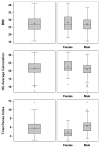Sarcopenia is an independent predictor of complications following pancreatectomy for adenocarcinoma
- PMID: 25556324
- PMCID: PMC4406850
- DOI: 10.1002/jso.23862
Sarcopenia is an independent predictor of complications following pancreatectomy for adenocarcinoma
Abstract
Background and objectives: Sarcopenia, which is subclinical loss of skeletal muscle mass, is commonly observed in patients with malignancy. The objective of this study is to determine the correlation between sarcopenia and operative complications following pancreatectomy for cancer.
Methods: A retrospective review of a pancreatectomy database was performed. The Hounsfield Unit Average Calculation (HUAC) of the psoas muscle, a marker of muscle density and fatty infiltration, was measured from preoperative CT scans. Complications were graded and multivariate logistic regression analysis was performed.
Results: One hundred eighteen patients met criteria for analysis; the overall morbidity rate was 78.8% (n = 93). There were 31 (26.3%) patients who met criteria for sarcopenia using the HUAC. When analyzed as a continuous variable, sarcopenia was an independent predictor of major grade III complications, length of stay, intensive care unit admission, delayed gastric emptying, and infectious, gastrointestinal, pulmonary, and cardiac complications.
Conclusions: These data suggest that sarcopenia as measured with the HUAC, a value that can be obtained from a preoperative CT scan, is a significant independent predictor of surgical outcome and can be used to improve patient selection and informed consent prior to pancreatectomy in patients with cancer.
Keywords: complications; pancreatectomy; pancreatic cancer; sarcopenia.
© 2014 Wiley Periodicals, Inc.
Figures
Comment in
-
Limitations of the definition of sarcopenia in cancer surgery.J Surg Oncol. 2015 Jul;112(1):116. doi: 10.1002/jso.23917. Epub 2015 May 13. J Surg Oncol. 2015. PMID: 25973597 No abstract available.
-
Response to letter to editor by Safer et al.J Surg Oncol. 2015 Jul;112(1):117. doi: 10.1002/jso.23968. Epub 2015 Jul 14. J Surg Oncol. 2015. PMID: 26175340 No abstract available.
References
-
- Shaib Y, Davila J, Naumann C, et al. The impact of curative intent surgery on the survival of pancreatic cancer patients: A U.S. Population-based study. Am J Gastroenterol. 2007;102:1377–1382. - PubMed
-
- Winter JM, Brennan MF, Tang LH, et al. Survival after resection of pancreatic adenocarcinoma: Results from a single institution over three decades. Ann Surg Oncol. 2012;19:169–175. - PubMed
-
- Mezhir JJ. Management of complications following pancreatic resection: An evidence-based approach. J Surg Oncol. 2013;107:58–66. - PubMed
-
- Grobmyer SR, Pieracci FM, Allen PJ, et al. Defining morbidity after pancreaticoduodenectomy: Use of a prospective complication grading system. J Am Coll Surg. 2007;204:356–364. - PubMed
MeSH terms
Grants and funding
LinkOut - more resources
Full Text Sources
Other Literature Sources
Medical
Miscellaneous


